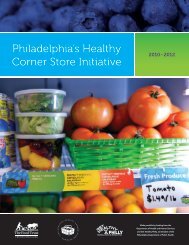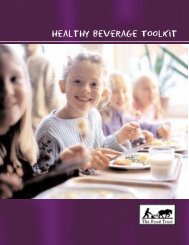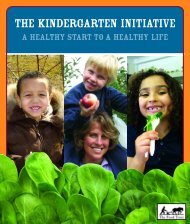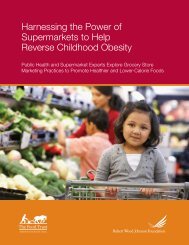The Grocery Gap: Who Has Access to Healthy - The Food Trust
The Grocery Gap: Who Has Access to Healthy - The Food Trust
The Grocery Gap: Who Has Access to Healthy - The Food Trust
Create successful ePaper yourself
Turn your PDF publications into a flip-book with our unique Google optimized e-Paper software.
PolicyLink<strong>The</strong> <strong>Food</strong> <strong>Trust</strong>Supply: Community <strong>Food</strong> Assessment. ARegional Approach for <strong>Food</strong> Systems inLouisville KY. Frankfort, KY: Community FarmAlliance, 2007. Available at http://www.communityfarmalliance.org/Bridging<strong>The</strong>Divide.pdf.18Community Health Councils Inc. DoesRace Define What’s in the Shopping Cart?Community Health and Education. Los Angeles,CA: Community Health Councils Inc., 2008.19Cotterill, R., and Franklin, A. “<strong>The</strong> Urban<strong>Grocery</strong> S<strong>to</strong>re <strong>Gap</strong>.” <strong>Food</strong> Marketing PolicyCenter, University of Connecticut. <strong>Food</strong>Marketing Policy Issue Paper 8 (1995).20D.C. Hunger Solutions. <strong>Healthy</strong> <strong>Food</strong>, <strong>Healthy</strong>Communities: An Assessment and Scorecardof Community <strong>Food</strong> Security In the Distric<strong>to</strong>f Columbia. Washing<strong>to</strong>n, DC: D.C. HungerSolutions, 2006. Available at http://www.dchunger.org/pdf/healthfoodcomm.pdf.21Fisher, B., and Strogatz, D. “Community Measuresof Low-Fat Milk Consumption: Comparing S<strong>to</strong>reShelves with Households.” American Journalof Public Health 89, no.2 (1999): 235–237.22Urban and Environmental Policy Institute. <strong>Food</strong><strong>Access</strong> in Central and South Los Angeles: MappingInjustice, Agenda for Action. A Report on ProjectCAFE: Community Action on <strong>Food</strong> Environments.Los Angeles, CA: Urban and Environmental PolicyInstitute, 2007. Available at http://departments.oxy.edu/uepi/cfj/publications/project_cafe.pdf.23Franco, M., Roux, A., Glass, T., Caballero, B.,and Brancati, F. “Neighborhood Characteristicsand Availability of <strong>Healthy</strong> <strong>Food</strong>s inBaltimore.” American Journal of PreventiveMedicine 35, no.6 (2008): 561–567.24Gallagher, M. Examining the Impact of <strong>Food</strong>Deserts on Public Health in Chicago. Chicago,IL: Mari Gallagher Research and ConsultingGroup, 2006. Available at http://www.marigallagher.com/site_media/dynamic/project_files/1_Chicago<strong>Food</strong>DesertReport-Full_.pdf.25Gallagher, M. <strong>The</strong> Chicago <strong>Food</strong> Desert Report.Chicago, IL: Mari Gallagher Research and ConsultingGroup, 2009. Available at www.marigallagher.com.26Galvez, M., Morland, K., Raines, C.,et al. “Race and <strong>Food</strong> S<strong>to</strong>re Availabilityin an Inner-City Neighbourhood.” PublicHealth Nutrition 11 (2007): 624–631.27Giang, T., Karpyn, A., Laurison, H., Hillier, A.,Bur<strong>to</strong>n, M., and Perry, D. “Closing the <strong>Grocery</strong><strong>Gap</strong> in Underserved Communities: <strong>The</strong> Creationof the Pennsylvania Fresh <strong>Food</strong> FinancingInitiative.” Journal of Public Health Managementand Practice 14, no.3 (2008): 272-279.28Glanz, K., Sallis, J., Saelens, B., andFrank, L. “Nutrition Environment MeasuresSurvey in S<strong>to</strong>res (NEMS-S) Development andEvaluation.” American Journal of PreventiveMedicine 32, no. 4 (2007): 282-289.29Hartford <strong>Food</strong> System. Connecticut’sSupermarkets: Can New Strategies Addressthe Geographic <strong>Gap</strong>s? Hartford, CT: Hartford<strong>Food</strong> System, 2006. Available at http://www.hartfordfood.org/pubs/supermarkets.pdf.30Helling, A., and Sawicki, D. “Race and Residential<strong>Access</strong>ibility <strong>to</strong> Shopping and Services.” HousingPolicy Debate 14, no.1 (2003): 69-101.31Horowitz, C., Colson, K., Hebert, P., andLancaster, K. “Barriers <strong>to</strong> Buying <strong>Healthy</strong><strong>Food</strong>s for People with Diabetes: Evidence ofEnvironmental Disparities.” American Journalof Public Health 94 (2004): 1549–1554.32Hosler, A., Rajulu, D., Fredrick, B., and Ronsani,A. “Assessing Retail Fruit and VegetableAvailability in Urban and Rural UnderservedCommunities.” Preventing Chronic Disease5, no.4 (2008): 1-9. Available at http://www.cdc.gov/pcd/issues/2008/oct/07_0169.htm.33Hosler, A., Varadarajulu, D., Ronsani, A., Fredrick,B., and Fisher, B. “Low-Fat Milk and High-FiberBread Availability in <strong>Food</strong> S<strong>to</strong>res in Urban andRural Communities.” Journal of Public HealthManagement Practice 12 (2006): 556–562.34Inagami, S., Cohen, D., Finch K. B., and Asch, S.“You are Where you Shop: <strong>Grocery</strong> S<strong>to</strong>re Locations,Weight, and Neighborhoods.” American Journalof Preventive Medicine 31, no.1 (2006): 10-17.35Jetter, K., and Cassady, D. “<strong>The</strong> Availability andCost of Healthier <strong>Food</strong> Alternatives.” AmericanJournal of Preventive Medicine 30 (2006): 38–44.36Kaufman, P. “Rural Poor Have Less <strong>Access</strong><strong>to</strong> Supermarkets, Large <strong>Grocery</strong> S<strong>to</strong>res.”Rural Development Perspectives 13 (1998):19–26. Available at http://www.ers.usda.gov/publications/rdp/rdp1098/rdp1098c.pdf.33






